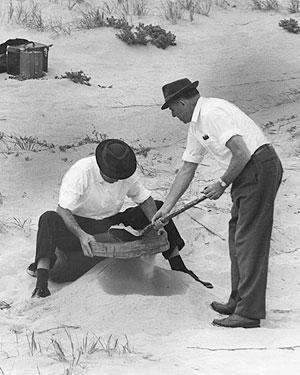
Christine Sharrock and Marianne Schmidt
- The "Wanda Beach Murders"

Detective Sergeant Alan Clarke and Detective Sergeant E. White of the CIB
Scientific Branch sift sand at the crime scene on Wanda Beach, 13 January 1964.
15 year olds Christine and Marianne were next door neighbours and best friends. On January 11th, 1965 the girls took Marianne's younger siblings to Cronulla Beach in Sydney. During the course of the afternoon the two older girls were separated from the younger children. Their mutilated bodies were found the following day partially buried in sand dunes at Wanda Beach near Cronulla. Their killer has never been found.
Christine Sharrock lived with her grandparents Jim and Jeanette Taig. Her father had died in 1958 and her mother Beryl had remarried and was living in the north-western Sydney suburb of Seven Hills. Christine had moved in with her grandparents by choice and when the Schmidts arrived next-door she developed a strong friendship with Marianne, who was the same age[2].
Marianne Schmidt had arrived in Melbourne from West Germany with her family in September 1958. At the time, the Schmidt family consisted of parents Helmut and Elizabeth and Marianne's siblings, Helmut Jr., Hans, Peter, Trixie and Wolfgang. Another child, Norbert, was born in Australia the following year. After arriving in Australia, the Schmidts lived in a migrant hostel in Unanderra before settling in Temora. In 1963 Helmut Schmidt moved the family to Sydney after contracting Hodgkin's disease and they found a home in the suburb of Ryde. In June the next year, Helmut Schmidt died[1].
Marianne's next-door neighbour was Christine Sharrock.
Two murders occurred during early 1966 which, police at the time speculated, might have been the work of the Wanda Beach killer.
On January 29, 1966, a cleaning lady named Wilhelmina Kruger was killed in the Piccadilly Arcade in Wollongong. Her body was discovered by a casual butcher when he arrived to work at the local butcher shop.She had been Strangled & Mutilated.Police believed that the murder might have been the work of the Wanda Beach killer, but would not say why.
On February 17, 1966, a prostitute named Anna Dowlingkoa went missing after leaving a nightclub in Kings Cross. Ten days later, her Mutilated body was found by a truck driver at the side of a road in Menai. Police immediately linked her murder with that of Wilhelmina Kruger. Again, they believed that the murder might have been the work of the Wanda Beach killer, but once again, would not say what led them to believe this. The murders of Wilhelmina Kruger and Annya Dowlingkoa are far less well known now than the Wanda Beach murders.
Cec Johnson, a former detective who had investigated the Wanda Beach murders, was given a painting in 1975 by Alan Bassett. Bassett had been jailed for murdering Carolyn Orphin, a 19 year old woman, in June 1966. Sent to prison for life, he served 29 years before being released in 1995.
The painting that Bassett gave Johnson showed an abstract landscape. Looking at the picture, however, Johnson became convinced that it showed a scene from the Wanda Beach murders that only the killer would know, as well as clues to the murders of Kruger and Dowlingkoa. He became convinced that Bassett was the Wanda Beach killer.
Other detectives were far less convinced, but Johnson wrote a book about the case. Before it could be published, however, he was knocked down and killed in an accident. The book was never published. Other detectives, while retaining professional respect for Johnson, concluded that he was wrong in his belief that Bassett was the killer.
One person he convinced, however, was crime reporter Bill Jenkings. Jenkings repeated Johnson’s claims in his ghostwritten memoirs, As Crime Goes By, devoting a whole chapter to the Wanda Beach murders. Most of the chapter was essentially a repeat of what he’d written in his earlier book Crime Reporter, but he mentioned Johnson, Bassett and the painting as well.
Bassett threatened legal action, but Jenkings died shortly afterwards, and Bassett did not go through with his threat. Since his release, Bassett has offered to give DNA to clear his name, but whether or not he has been eliminated as a suspect by DNA has yet to be publicised.
Another suspect, not well publicised until 1998, is Derek Percy. Percy has been imprisoned since 1969 for the murder of a child on a beach in Victoria. He is considered too dangerous to be released and is the prime suspect for a number of other murders of children in Melbourne and Sydney.
A third suspect is Christopher Wilder. Wilder was known to police in Sydney but did not become infamous until he became a serial killer in America in the early 1980s. In the first half of 1984, he committed eight murders and attempted several more. He accidentally killed himself during a struggle with police in New Hampshire on April 13, 1984.